Buenos Aires – A mattarello or matterello is a thin rolling pin, often without handles, that is used for rolling out pasta by hand. Whether or not the folks at Il Matterello, Martín Rodríguez 517 in La Boca are rolling out their pasta using one, I don’t know, I didn’t look back in the kitchen. But they’re certainly turning out some amazingly good pasta! The restaurant is located on a typical Boca down-at-heels street, not too far from the Boca Juniors futbol stadium. From the outside it doesn’t look like much, but step inside and down the steps and you’ll find yourself seated comfortably at one of the white tablecloth covered tables, seated amongst local businessfolk with a smattering of tourists and others who’ve heard of the place. The walls are lined with travel posters advertising various parts of Italy, the ductwork is bare steel hanging from an acoustic tiled ceiling, there’s a bit of a clatter from the open kitchen at the rear, and everyone’s having a great time.
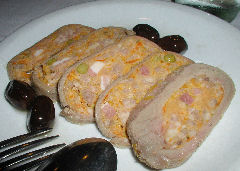 Start off with a platter of mixed antipasto, with a standard but oh so good assortment of roasted and preserved vegetables, boconcini, and olives; or maybe a platter of classic Italian sausages and cured meats. Don’t even consider passing up a plate of the Cima a la Genovese (in Italian, Cimma alla Genovese), a classic Ligurian dish of breast of veal stuffed with a variety of vegetables, poached, sliced, and served at room temperature with top quality olive oil to drizzle over it. No doubt this is the dish that inspired the local matambre that porteños happily eat, as often as possible. The owners of Il Matterello, by the way came from Genoa in Liguria and Molino in Emilia-Romagna, and traditional dishes from each place grace the menu.
Start off with a platter of mixed antipasto, with a standard but oh so good assortment of roasted and preserved vegetables, boconcini, and olives; or maybe a platter of classic Italian sausages and cured meats. Don’t even consider passing up a plate of the Cima a la Genovese (in Italian, Cimma alla Genovese), a classic Ligurian dish of breast of veal stuffed with a variety of vegetables, poached, sliced, and served at room temperature with top quality olive oil to drizzle over it. No doubt this is the dish that inspired the local matambre that porteños happily eat, as often as possible. The owners of Il Matterello, by the way came from Genoa in Liguria and Molino in Emilia-Romagna, and traditional dishes from each place grace the menu.
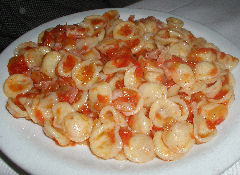 Personally, I can’t tell the difference between strascinati, which these are, and orecchiete, which is what they look like to me. In fact, I’d never heard of strascinati in all my time in various Italian restaurants and travel in Italy, yet, it turns out, they do exist, and are well known. Wikipedia says that they’re the Ligurian version of orecchiete, which are from Apuglia, but says they’re not dome-shaped, however an internet search on strascinati reveals picture after picture of dome-shaped pasta – besides, if they were the same except for not being domed, they’d just be flat little circles of dough. Regardless, we found ourselves digging into a delightful plate of the stuff, tossed with a quite good amatriciana sauce, classically made with tomato, onions, and guanciale which is a bacon made from pig’s cheeks – here made with pancetta, which is different, but still very tasty.
Personally, I can’t tell the difference between strascinati, which these are, and orecchiete, which is what they look like to me. In fact, I’d never heard of strascinati in all my time in various Italian restaurants and travel in Italy, yet, it turns out, they do exist, and are well known. Wikipedia says that they’re the Ligurian version of orecchiete, which are from Apuglia, but says they’re not dome-shaped, however an internet search on strascinati reveals picture after picture of dome-shaped pasta – besides, if they were the same except for not being domed, they’d just be flat little circles of dough. Regardless, we found ourselves digging into a delightful plate of the stuff, tossed with a quite good amatriciana sauce, classically made with tomato, onions, and guanciale which is a bacon made from pig’s cheeks – here made with pancetta, which is different, but still very tasty.
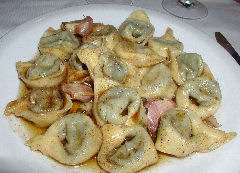 Feel free to salivate while just looking at this dish. A classic of the Emilia-Romagna region, tortelli are plump, stuffed, “torus-shaped”. In this case, Tortelli Bianchi con Manteca Quemada y Ajo, they are simple but excellent pasta rings filled with cheese and vegetables and topped with a delicious and subtle brown butter sauce with whole roasted garlic cloves. That’s my idea of simple but excellent. Tortelli are the house specialty, and come in several versions, and looking around the room, it’s clear they’re a favorite of the patrons as well.
Feel free to salivate while just looking at this dish. A classic of the Emilia-Romagna region, tortelli are plump, stuffed, “torus-shaped”. In this case, Tortelli Bianchi con Manteca Quemada y Ajo, they are simple but excellent pasta rings filled with cheese and vegetables and topped with a delicious and subtle brown butter sauce with whole roasted garlic cloves. That’s my idea of simple but excellent. Tortelli are the house specialty, and come in several versions, and looking around the room, it’s clear they’re a favorite of the patrons as well.
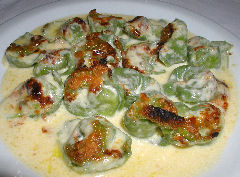 Good as the tortelli bianchi were, the true specialty of the house is their tortelli verde, made with a spinach pasta, filled with a roasted garlic and cheese mixture, and then topped with this creamy mixed butter, bechamel, and cheese sauce that’s been browned under a broiler, giving a touch of crunch. It would be hard to imagine tortelli being much better than these, and we could have happily eaten another plate or two just of this dish. If you were to have nothing else at Il Matterello, you need to eat these, oh, and the Cima too, and maybe…
Good as the tortelli bianchi were, the true specialty of the house is their tortelli verde, made with a spinach pasta, filled with a roasted garlic and cheese mixture, and then topped with this creamy mixed butter, bechamel, and cheese sauce that’s been browned under a broiler, giving a touch of crunch. It would be hard to imagine tortelli being much better than these, and we could have happily eaten another plate or two just of this dish. If you were to have nothing else at Il Matterello, you need to eat these, oh, and the Cima too, and maybe…
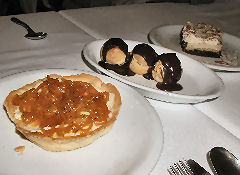 We decided to go with our waitress’s recommendations for desserts, and in short order found ourselves with three marvels of the pastry world. A Crostata de Naranja is a deceptively simple delicate tart crust filled with vanilla pastry cream and topped with a whole lot of candied orange peel. The Bigné, which is the Italian term for what most of us know as profiteroles are small puffs of dough filled with your choice of ice cream or pastry cream, in this case, chocolate ice cream, and topped with a mix of caramel and chocolate sauces. And, of course, the classic Torta della Nonna with its layers of vanilla and chocolate pastry cream, nuts and coconut topping – not anything like what my grandmothers used to make. But then, I don’t remember either of them ever making a torte, or dessert for that matter, and they weren’t Italian.
We decided to go with our waitress’s recommendations for desserts, and in short order found ourselves with three marvels of the pastry world. A Crostata de Naranja is a deceptively simple delicate tart crust filled with vanilla pastry cream and topped with a whole lot of candied orange peel. The Bigné, which is the Italian term for what most of us know as profiteroles are small puffs of dough filled with your choice of ice cream or pastry cream, in this case, chocolate ice cream, and topped with a mix of caramel and chocolate sauces. And, of course, the classic Torta della Nonna with its layers of vanilla and chocolate pastry cream, nuts and coconut topping – not anything like what my grandmothers used to make. But then, I don’t remember either of them ever making a torte, or dessert for that matter, and they weren’t Italian.
Overall, really excellent food, and good, friendly service. Prices aren’t bad, running around 15 pesos for a plate of excellent pasta. They’ve got a good wine list (we had a good, if slightly oaky for my tastes, bottle of 2003 Bodega Los Cerrillos “El Peral” Malbec, for a mere 27 pesos). My only criticism, the coffee, which tasted quite burnt – time to clean and adjust the espresso machine – but that’s not enough to stop me from going back, and soon!
Both those dishes of tortelli are indeed making my mouth water. 15 pesos per dish is a steal compared to Cartoon place you ate at.
And far better quality than Cartoon! Not that Cartoon specializes in pasta. This was pretty much the best Italian food I’ve had since getting here. Admittedly, I love the freshness at Don Chicho that I’ve mentioned, but that’s for much simpler, very basic pasta.
[…] I’d agreed to provide Alberto with his requested dulce de leche, even if I wasn’t going to tell him what I was going to make from it. I was inspired a bit by that extraordinary orange custard tart I had a week or two ago at Il Matterello. Step one, of course, was to make the dulce de leche. Yes, make it. I have yet to find a commercial one that isn’t just over-the-top cloyingly sweet, not to mention tasting a trifle, well, commercial – after all, they add things to them to stabilize them for sitting on shelves in supermarkets. And the really good artesanal ones are outrageously expensive. This is going to sound like a joke, but it’s not, and a few minutes’ online research will show you I’m not making this up. Buy some cans of sweetened condensed milk. Put them in a large pot (unopened!) and fill with cold water that covers the cans by at least 3-4″ – you need water pressure above the cans to stop them from blowing up. Bring to a boil over medium heat and then turn the heat down to very low, to keep just a bare simmer going. Let them simmer for exactly 3½ hours. Less and the dulce de leche won’t be done, you’ll have caramel soup, more and it gets too dark and tastes slightly burnt. Turn off the heat, and let them cool in the water. When cool, open and enjoy. For presentation, I decided to do something slightly different, and picked up some phyllo dough. I’m not going to get into the intricacies of working with phyllo, but I like the way it ends up when making tart shells – a bit freeform. […]
[…] Buenos Aires – I am once again guilty of only semi-following instructions. It started with a surprise encounter in a restaurant. Last week I was with some friends from Uruguay who were in visiting for a couple of days and they wanted good pasta. I’d suggested we meet at Il Matterello, holding strong as my favorite pasta place so far in the city. Midway through our meal a group of four came in and sat at the next table – the young man at the table kept looking over at me and smiling – well, what is one to think? Then he chatted with the owner who was also taking care of his table, and she came over and asked me if I write a blog, in which I’d reviewed her restaurant – I answered affirmatively, she nodded at him, and he exclaimed something to the effect of “I thought so!” Damn, maybe I should take that little photo off the top of the site. […]
[…] many moons ago I wrote up the great pastas at Il Matterello in La Boca. I’ve been back a few times over the years, and it has stayed steadfastly one of my favorite […]
[…] that leads up to, it’s been a whopping 12 years since I reviewed Il Matterello, Martín Rodríguez 517 in La Boca. At the time, I declared it the best pasta […]